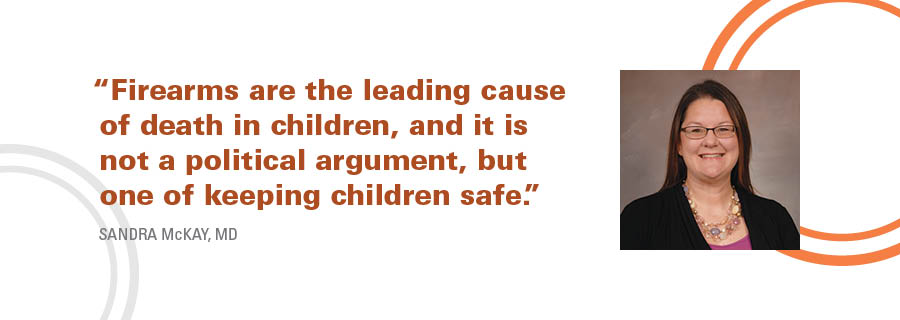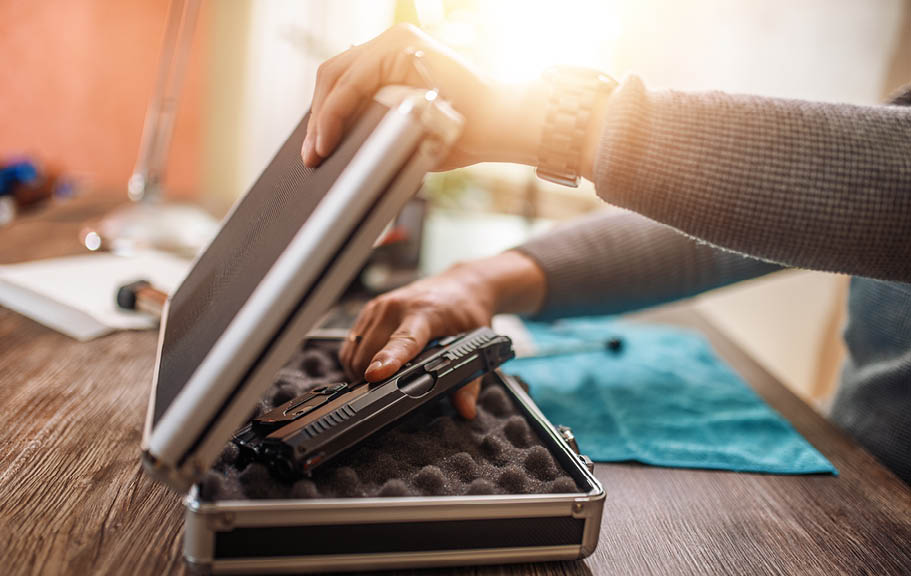There’s no question that gun violence and safety is a pressing issue in the United States, and with how politically charged it has become, the discussion can get heated very quickly. Each side of the debate has its own ideas and goals to solve the problem.
But for Sandra McKay, MD, there’s only one goal in mind: keeping people safe around firearms. “Firearms are the leading cause of death in children, and it is not a political argument, but one of keeping children safe. Firearm suicide is far too common, and understanding how we can promote awareness in our communities to reduce this is the key first step to saving lives.”
In 2019, McKay, an associate professor in the Department of Pediatrics, helped McGovern Medical School become one of just two schools in the country to include work in gun violence as part of the medical curriculum. After years of work, what started as a Blue Book elective at McGovern is now included in the full-time curriculum.

McGovern Medical School students receive a required one-hour training on gun safety in their first year and are then given the option to take up to six hour-long electives centering around gun violence and safety.
“We must empower physicians in training to feel comfortable talking about firearms within the clinical encounter just as if it were diabetes or heart disease,” McKay said. “A simple conversation or question may be the difference between life or death for a family.”
For McKay, however, integrating gun safety into the curriculum is just the foundation for her long-term goals. McKay’s desire to educate on firearm safety spreads far beyond the classroom into the community, state, and national levels.
In October 2023, McKay and her co-principal investigator Alexander Testa, PhD, assistant professor in the Department of Management, Policy, and Community Health at the UTHealth Houston School of Public Health, received a $6.2 million grant funded by the National Institute of Nursing Research to establish a hospital-based intervention program to address firearm violence. The Houston Violence Intervention Program was the first of its kind in the city of Houston and aims to prevent firearm-related injuries.
“This program has the chance to directly affect the lives of thousands, tens of thousands, of people in Houston, and it’s going to indirectly affect the lives of tens of thousands of more people, their families, their friends, and their networks,” Testa said. “So, I think this program holds a lot of potential to save a lot of lives, make Houston safer, and deliver a large cost-effective return on assets and residents.”
Just eight months later, McKay received a $60,000 Category 1 grant from Kaiser Permanente to help supplement the Houston Violence Intervention Program and help build the capacity of organizations and individuals involved in gun violence prevention research.
“This funding is essential to the formation of the HVIP as we work to bring the community together to create a program that will truly impact the landscape of community violence,” McKay said.
With programs established in the Greater Houston Area, McKay has now set her sights on helping to prevent firearm violence throughout the state of Texas. One area of prevention that McKay will focus on is the safe storage of firearms.
According to a study published by the CDC in June, 43% of households store loaded guns in the home, while more than half of those households do not store them in locked containers. Even though there are solutions like safes, or a myriad to help make firearms safer, accidental deaths due to improper firearm storage continue to be a problem.
Nationally, the Bureau of Alcohol, Tobacco, Firearms and Explosives has created a program for safe storage of firearms. The program offers information on temporary out-of-home storage for people struggling with mental health crises or for non-life-threatening situations such as simply going out of town. While other states have adopted these policies, McKay is leading the charge to help bring similar programs to Texas.
After receiving grants to study secure storage locally in the community, McKay and others around the state have formed a coalition in Texas to explore options on how to best disseminate information on safe storage.
“We’ve learned that the current messages only resonate with non-firearm owners,” said McKay, the Huffington Fellow in Child Health Policy at Rice University’s Baker Institute for Public Policy, and a firearm owner herself. “We need to educate not only our health care community but also the firearm community about safe storage. Secure storage is not controversial. We can have that conversation.”
Target Safety, which is focused on promoting secure storage options within communities, highlights how families can not only securely store firearms within their homes, but also access temporary out-of-home storage options during times of crisis. These types of programs have been successfully implemented in states like Colorado and Louisiana, and McKay is seeking to study the implementation of this program in Texas. She aims to use culturally competent messaging to promote the program, and study the reach of the program in the community setting. She said she is excited to partner with the coalition to collaborate with firearm owners in Texas to promote secure storage and ultimately save lives.
“In this community, we are a team,” McKay said. “There are so many people working alongside us in this process. We can do this in Texas, and we can do it well in Texas.”
